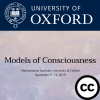Xerxes Arsiwalla - Computing Meaning from Conceptual Structures in Integrated Information Theory
Xerxes Arsiwalla
Institute for Bioengineering of Catalonia Barcelona, Spain
Theories of consciousness such as Integrated Information Theory (IIT) and its various approximations are grounded on intrinsic information and causal dynamics. However, what seems to be missing or at least is not explicitly addressed in this framework is the role of meaning. One could argue that conscious experience not only generates information, but also meaning. We postulate that meaning associated to experience is intrinsically generated, is compositional, specific and integrated. How can this be formalized within the context of IIT? Here we propose a framework for computing the compositional meaning of the maximally irreducible conceptual structure or Q-shape in IIT.
A Q-shape is a set of concepts and their relations. To compute the meaning of a Q-shape we apply the category theoretic formulation of Distributional Semantics, used in natural language processing. This assigns to every concept in the Q-shape, a distributional meaning and a grammatical type. By consistency, concepts with very high phi (core concepts) will be the most pertinent for the experience at that specific instance. The distributional meaning of each core concept depends on its relations to all other concepts in the Q- shape and can be computed using a vector space spanned by a basis of concepts as is done in Distributional Semantics.
The grammatical types associated to core concepts are constrained by their relations to other core concepts. Furthermore, a pre-group algebra imposes ordering of grammatical types. We then show how the sub-network of core concepts in the Q-shape can be identified with a category theoretic process diagram. The compositional meaning of this process diagram is computed within a monoidal category and yields the meaning associated to the experience. We demonstrate this computation with a simple toy model. Finally, we comment on how meaning imposes phenomenologically relevant constraints to any information-based theory of consciousness.
Filmed at the Models of Consciousness conference, University of Oxford, September 2019.




